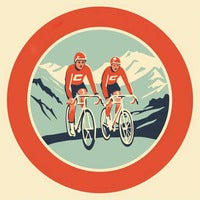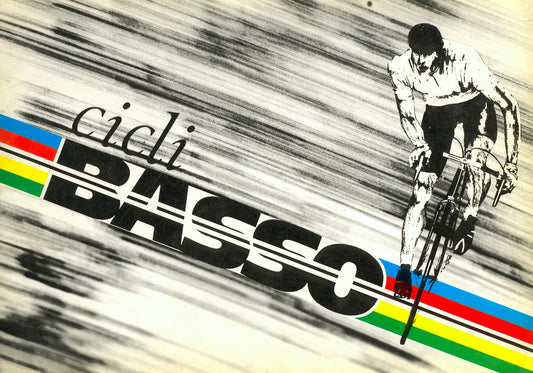There’s a special kind of magic in leafing through a vintage cycling catalogue. Time seems to slow; you can almost hear the soft hiss of brazing torches and smell the metallic tang of freshly milled steel. In the early 1980s—well before carbon fiber became the standard—brands like Basso in the Veneto region of Italy were forging steel frames with equal parts artistry and science. This glimpse into a 1981 Basso catalog captures that balance perfectly.

Veneto: Home to Cycling Dreams
If you’ve ever visited Northern Italy, you might recall the unique charm of the Veneto region. Gentle hills roll out into distant mountains, and it seems like every winding road has been touched by the pedals of local riders. The 1981 Basso catalog highlights this heritage clearly with a simple yet colorful map, showing famous cities like Vicenza and Treviso. The text speaks to how cycling is woven into everyday life, whether you’re a commuter, a hobby rider, or an aspiring professional.
It’s no coincidence that world-renowned cycling companies—Campagnolo among them—call Veneto home. The area’s blend of terrain and tradition fosters an enthusiasm for bicycles that’s hard to miss. People don’t just ride here; they live cycling. This deep-rooted passion influenced Basso’s frame-building philosophy: the belief that quality materials and meticulous craftsmanship can produce bikes worthy of the region’s storied roads.

The Frame as the Heart of the Bicycle
Right at the start of the catalog, a line stands out: “If we were to make a comparison between the human body and the bicycle, we could say that the frame is the heart.” It’s a subtle statement, but it conveys the emotional connection between rider and machine.
In the accompanying images, you see steel tubes laid out neatly—top tube, down tube, seat tube, chainstays, and seatstays—ready for transformation into a racing frame. Each component has its own function and precise measurements. At the time, Basso favored carbon-steel tubing from the likes of Columbus (Z-type, among others) because it balanced strength with a relatively light weight.

Frame Components & Geometry
A bicycle’s soul lies in its geometry—the angles, lengths, and gauge of the tubes. In the 1981 catalog, Basso underscores that dimensions and alignments must be exact. If you ever wondered why vintage steel frames can feel so lively and responsive, it’s partly because builders in this era devoted immense attention to every millimeter.
You’ll notice references to:
- Bottom Bracket: The pre-heating step ensures a clean, strong braze and reduces stress in critical load-bearing areas.
- Fork & Rear Tips: Typically cut and mitered to match the rest of the frame, forming the all-important link between the wheels and the road.
- Dropouts: Pressed from steel or machined, dropouts anchor the wheel axles—a small detail with a large effect on handling and reliability.

The Art and Science of Brazing
It’s hard not to be captivated by the fiery images of brazing torches, molten metal, and glowing lugs. To Basso, brazing wasn’t just a way to fuse tubes; it was the keystone of frame integrity. The catalog explains in detail how using an oxypropane or oxyacetylene flame (with or without pre-heating) could impact the final strength of a frame. Metallurgical tests—complete with graphs of Vickers hardness—reveal how higher temperatures affect the tube’s crystalline structure.
- Pre-heating: Helps maintain consistency in the steel’s microstructure, preventing “hot spots” that might weaken the frame.
- Microhardness Testing: Samples were taken at intervals along the brazed joint, showing how the heat-affected zone varies. The result? Frame builders learned exactly how to preserve as much of the steel’s original strength as possible.
These details may seem technical, but they reflect the era’s blend of hands-on craftsmanship and practical science. Frame builders like Basso recognized that if they wanted to maintain a competitive edge, they needed to understand the nuances of brazing down to a microscopic level.

Rigorous Quality Control
From the photos, you can see careful inspections taking place. Workers (often in simple green or blue shop coats) bend over alignment tables, verifying rear triangles, seat lugs, and forks with dial indicators to ensure everything meets tight tolerances. Some images show a semi-automated brazing station—relatively high-tech for the period—signaling that while much was done by hand, Basso also embraced efficiency where it made sense.
Even more telling are the final checks:
- Liquid Penetrant Tests: Used to detect any hairline cracks in welds or lugs.
- Visual Inspection: Each frame is scrutinized under bright lights; any flaw risks the brand’s reputation.
This combination of craft and care helped maintain consistency in every frame that left Basso’s workshop.
Veneto Cycling Tradition Writ Large
Scattered throughout the catalog are photos of local Veneto scenery: rolling landscapes, cobbled streets, and groups of cyclists in bright kits pedaling through sunlit roads. There’s a nod to the region’s history of producing great racers—sons and daughters of the Veneto who conquered mountain climbs and sprint finishes alike. The text celebrates cycling not just as a sport, but as a shared cultural experience.
In that sense, the 1981 Basso catalog feels like a snapshot of a community in motion, proof that the brand’s approach to frame-building was shaped by its surroundings. Here, bikes were built to withstand the rigors of training on rougher country roads, but also to shine under race-day pressures.
A Glimpse at the 1981 Basso Model Range
Turning further into the 1981 catalog, we find a striking gallery of complete bicycles—each painted in bold, vivid hues against a bright red backdrop. These images offer a wonderful snapshot of the era’s aesthetic: elegant steel tubing, gleaming chrome accents, and the timeless simplicity of traditional lugwork. Basso gave each model a distinct personality, pairing carefully chosen component groups with frames matched to their purpose.

Mod. Gap-Pista
This red track bike stands out immediately, its fixed-gear drivetrain and lack of brakes revealing a dedication to pure velodrome racing. The frame, built from Columbus SL tubing, is fitted with Campagnolo Record Pista components, Nisi tubular rims, and Clement Pista tires—hallmarks of a high-performance track machine of the day. One look at the slim fork crown and razor-straight seatstays, and you can almost hear the whoosh of this bike circling the boards under a flurry of pedal strokes.

Mod. Arenaccia
In contrast to the single-minded Gap-Pista, the Arenaccia appears as a bright gold road bike with more versatile gearing. Closer inspection of the component chart in the catalog reveals a mix of Rino-branded parts, Modolo brakes, and Regina drivetrain elements. It’s a reminder that, while Campagnolo dominated the top-tier groups at the time, smaller Italian component makers also had a loyal following. From the gracefully curved fork to the comfortable road geometry, the Arenaccia was built for riders seeking both reliability and a dash of Basso’s signature style.

Mod. Gap
Sharing its name with the Pista but aimed squarely at road competition, the Mod. Gap is another high-level machine—this time outfitted with a Campagnolo Super Record group. The golden finish on the frame is more than cosmetic; combined with Columbus SL steel, it echoes Basso’s pursuit of lightweight efficiency. Whether ascending mountain passes or flying down straights, a Super Record-equipped Gap would have offered a professional feel for amateur racers dreaming of crossing finish lines.

Mod. Vuelta
Finally, the silver-hued Vuelta rounds out the selection as a solid all-around road bike using Columbus Zeta tubing and a Campagnolo Gran Sport kit. This build strikes a balance between performance and accessibility—ideal for the rider who wanted reliable Campagnolo engineering without venturing into top-shelf territory. From weekend group rides to spirited daily commutes, the Vuelta embodies the ethos of a classic Italian road bicycle: functional, tasteful, and ready for miles of scenic Italian roads (or wherever your own cycling journey might take you).
Just like the workshop photos of brazing and frame alignment, these completed bikes capture a certain romance. The contrasting colors, the iconic Campagnolo logos, and the precisely machined steel remind us that in 1981, a handmade bike from the Veneto was more than a sum of its parts—it was a statement of passion, both from the artisans who built it and the cyclists who rode it.
What These Pages Mean Today
Looking back over four decades later, these pages exude a quietly confident nostalgia. Steel frames are still cherished by many cyclists for their ride quality and timeless aesthetic. Yes, modern materials like carbon fiber have transformed racing bikes in ways unimaginable in 1981. But the underlying principles—precision geometry, thoughtful metalwork, and a deep love of the ride—remain constants.
For collectors and restoration enthusiasts, a vintage Basso frame embodies that golden era when craftsmanship and engineering were so carefully intertwined. Maybe you’ve stumbled upon a dusty steel Basso in an old garage sale or inherited one from a friend. Holding it in your hands, you can feel the echoes of the brazing torch and that old alignment jig—reminders that this frame once passed through a workshop in Veneto, guided by skilled tradesmen who knew they were building something special.
Carrying the Torch Forward
While the cycling world spins faster each year—new technologies, aerodynamic shapes, even electronic shifting—the story found in these 1981 catalog pages remains relevant. Techniques like precise mitering, controlled brazing temperatures, and thorough inspection aren’t just for steel frames from decades past. They inform all quality bicycle manufacturing even now, whether the material is steel, aluminum, titanium, or carbon fiber.
Basso’s dedication to “doing it right” reminds us that behind every great bicycle, there’s a mix of learned expertise and personal pride. That intangible quality persists: it’s what makes riding a well-crafted bike feel like more than just turning pedals.
A Final Word on Nostalgia
It’s easy to romanticize the past, particularly when you see these old photos of flame-brazing and manual inspection. But for those of us with a soft spot for classic steel frames, a healthy dose of nostalgia is warranted. The 1981 Basso catalog stands as a testament to an era when tradition and innovation walked hand in hand.
So the next time you spot a vintage steel Basso—maybe with the brand’s signature head badge or that subtly curved fork—pause and remember the workshop scenes in these catalog pages. Recall the swirling glow of the torch and the quiet determination of the workers. Even today, that legacy endures in every brazed seam, every lug, and every pedal stroke along Veneto’s storied roads.
Because in cycling—especially in the Veneto—some things never truly go out of style.


